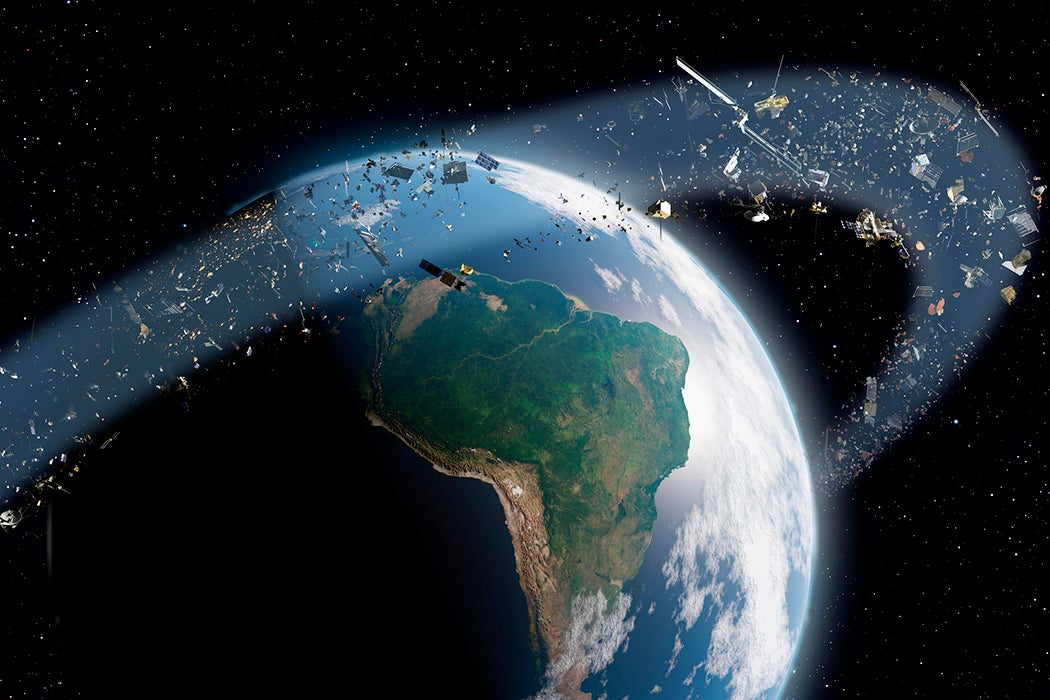There isn’t a place on Earth we haven’t left our trash, from deepest ocean trench to highest mountain. And sixty-seven years on from Sputnik, it turns out we’ve dumped plenty of garbage outside of the Earth as well. Debris is so omnipresent in Earth orbit, warns Nicholas Peter of the International Space University, that it’s a serious threat to the ever-expanding space economy.
“The term ‘orbital debris’ refers to anything in space that is not being used for practical purposes,” Peter explains, “whether that’s defunct satellites, spent rocket bodies, broken pieces of satellites, or shards of material, etc…. [E]ven a small fragment of paint can damage a satellite in orbit when colliding with it.”
This is because the debris is hurtling around at 10km/second, or more than ten times the speed of a bullet.
Peter notes that the European Space Agency estimates there are some 34,000 human-made objects larger than a tennis ball orbiting the Earth, with only about 13 percent of them in active operation. The 2013 film Gravity dramatized the hazardous potential of space debris on humans in orbit, but most of the danger is to the proliferating number of satellites.
The number of payloads delivered into orbit each year by both state and corporate entities surpassed 2,000 for the first time in the year 2022. That year, global revenues from “space sector” reached upwards of $300 billion. In 2023, it was 2,911 payloads. Plans are underway for “mega constellation” fleets of more than 1,000 satellites each.
“The dependency of advanced economies on space-enabled services and capabilities is estimated to grow over time. Satellite data has become ever-more important, both in terms of demand, and in terms of application and service providers,” Peter writes.
More to Explore
Losing the Night Sky
But more satellites mean more debris and more chances of making more debris by collision with other satellites. There’s a vicious circle in orbit. Previous to 2009, known collision incidents were between debris and satellite, but that year two satellites, one active, one defunct, smashed into each other and generated “more than 2,300 trackable fragments.”
There have also been at least sixteen Anti-Satellite Tests (ASATs)—typically ballistic missiles launched by the US, China, Russia, or India against one their own satellites—that have “resulted in over 6,300 pieces of debris.” The US committed to stop testing ASAT missiles in 2022.
Some satellites are moved into so-called graveyard orbits after their operational life ends, where they’re supposed to be out of the way for centuries if not longer. Material in low-Earth orbit, defined as less than 200km from Earth, is intended to re-enter the atmosphere and burn up. Time to “deorbiting” depends on “size, shape, and importantly, altitude.” The higher up, the longer it takes to burn-up in atmospheric reentry. Therefore, as Peter notes, “a satellite orbiting at 700km could take a thousand years to deorbit without any intervention.”
Weekly Newsletter
What’s to be done? Peter argues for better monitoring and “active debris removal.” Both the European Space Agency and the Japan Aerospace and Exploration Agency, each teaming up with private companies, have already demonstrated missions that targeted defunct satellites and discarded rocket bodies. These missions have of course involved more launches, so a Space Sustainability Rating initiative aims to “promote mission designs and operational concepts that mitigate debris creation.”
All to the good, yet the global rise of authoritarian oligarchies and the seeming inevitability of conflict, potentially including space war, bodes ill for rational and reasonable international responses to the problem. The future of a US commitment to an ASAT ban is, for instance, unknown at this time.
Is the space debris forecast to be set on permanent orbital hailstorms?
Support JSTOR Daily! Join our membership program on Patreon today.








